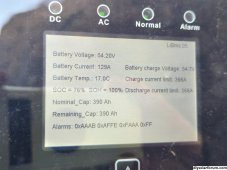tve
New Member
I've been troubleshooting an issue with my Sol-Ark & Discover batteries, which is that I couldn't get the Sol-Ark to charge the batteries from grid at full current (275A).
Goal: ensure batteries are charged 100% just before the peak rate period starts at 4pm (California)
In the summer this hasn't been a problem thanks to solar charging the batteries all morning, but now I'd like the Sol-Ark to top off the batteries as late as possible just before 4pm, so it gives the solar a max chance to do what it can. Hence I'd like to charge at 275A from ~2:30pm-4pm. The batteries can take 367A of charge current, I have 2x 2/0 wires wired to both lugs on the Sol-Ark.
What I observe is that the batteries charge around 80A, give or take 10A, regardless of me tweaking settings. After a lot of ? I discovered that the problem lies in the battery to Sol-Ark communication (set-up using a Discover Lynk II, as approved and documented by both Discover and Sol-Ark). I don't know what exactly the Lynk tells the Sol-Ark but I see the "absorption-voltage" (modbus register 202) changing over time, presumably set by the Lynk over CAN. That voltage is not very high, e.g. <54V when the battery is ~20% SOC. It seems to always be 0.5V above "real time battery voltage" (modbus 317). Sooo, what seems to happen is that the Lynk tells the Sol-Ark this charging voltage, the Sol-Ark outputs that voltage, and the current results, and it's too little.
To test my hypothesis, I turned the CAN communication off and set the absorption voltage manually to something a bit higher and lo and behold I can push >270A into the battery! Is this how it works? The BMS tells the Sol-Ark the voltage to output and supposedly tunes that to adjust the current it would like to see??? I would have thought the BMS would communicate a max charge current and let the Sol-Ark figure out what voltage it takes to push the current. Odd.
I have a ticket open with Sol-Ark and one with Discover, let's see... I wonder how well this works with other BMS brands...
Goal: ensure batteries are charged 100% just before the peak rate period starts at 4pm (California)
In the summer this hasn't been a problem thanks to solar charging the batteries all morning, but now I'd like the Sol-Ark to top off the batteries as late as possible just before 4pm, so it gives the solar a max chance to do what it can. Hence I'd like to charge at 275A from ~2:30pm-4pm. The batteries can take 367A of charge current, I have 2x 2/0 wires wired to both lugs on the Sol-Ark.
What I observe is that the batteries charge around 80A, give or take 10A, regardless of me tweaking settings. After a lot of ? I discovered that the problem lies in the battery to Sol-Ark communication (set-up using a Discover Lynk II, as approved and documented by both Discover and Sol-Ark). I don't know what exactly the Lynk tells the Sol-Ark but I see the "absorption-voltage" (modbus register 202) changing over time, presumably set by the Lynk over CAN. That voltage is not very high, e.g. <54V when the battery is ~20% SOC. It seems to always be 0.5V above "real time battery voltage" (modbus 317). Sooo, what seems to happen is that the Lynk tells the Sol-Ark this charging voltage, the Sol-Ark outputs that voltage, and the current results, and it's too little.
To test my hypothesis, I turned the CAN communication off and set the absorption voltage manually to something a bit higher and lo and behold I can push >270A into the battery! Is this how it works? The BMS tells the Sol-Ark the voltage to output and supposedly tunes that to adjust the current it would like to see??? I would have thought the BMS would communicate a max charge current and let the Sol-Ark figure out what voltage it takes to push the current. Odd.
I have a ticket open with Sol-Ark and one with Discover, let's see... I wonder how well this works with other BMS brands...



